Choosing an outdoor coating is a difficult task. It should be reliable, wear-resistant, beautiful, non-slip, durable. It is also desirable that it easily fit. All these conditions satisfies the PVC tile for the floor.
What is PVC (vinyl) floor tile
Not so long ago, another type of PVC coating appeared on the market - vinyl tile. She is something similar to a good linoleum (hence another name - linoleum), but the production technology is different, like the release form. This material is cut into rectangles or squares, it may be on an adhesive base or without it. It has no one name - LVT tile (LWT) - Reducing the English name Luxury Vinyl Tile. Design or art tile is also clear - copyright coatings create from squares or rectangles.
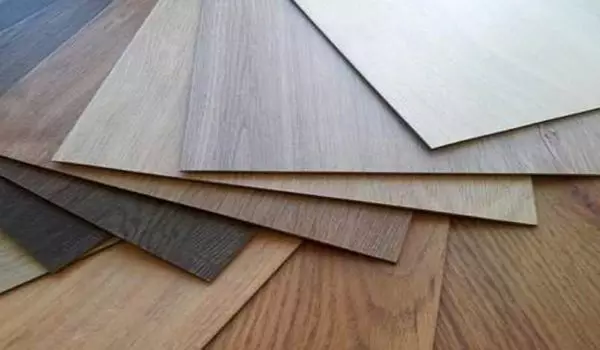
PVC Sex Tile Coloring A lot
The release form turned out to be so comfortable that the market quickly conquers. It is easier to fit, more economical. Not in the sense of the price - it is just high (at the level of the linoleum of the commercial class), and in the sense of the fact that cropping remains at least less than when using linoleum. In this, and in excellent performance and consists of a secret of its growing popularity.
PVC tile for the floor consists of vinyl and resin, which add stabilizers, plasticizers, sometimes fillers (to give specific properties or a special appearance). The warm-up mixture is pressed. The resulting material is characterized by high density, but remains flexible and plastic.
PVC tile consists of several layers:
- Two basic layers.
- Film with a pattern.
- Protective layer of transparent PVC.
- Wear-resistant polyurethane layer.

PVC Floor Tile Build
In the composition there are two types of linoleum tiles: vinyl and quartzinyl (vinyl quartz). The second option is more expensive, but also more dense, with elevated wear-resistance.
Types and varieties
By the method of laying there is a PVC tile for a floor on a self-adhesive basis, there is an ordinary (for the installation of the second type the glue is required). Finishing material for the floor of this type is pasted on an even clean base. With this method of installation, the flooring forms a monolith with the base.
There is a tile with locks - mechanical and adhesive. Elements are connected with each other with these locks, and the coating itself is obtained unrelated with the base. This option is called "floating" floor.
Like linoleum, PVC tiles for the floor has a classification by the degree of load:
- Class 23- 31 is suitable for rooms with a small number of visitors. It can still be called domestic. The linoleum tile of this class is the cheapest, has a thickness of up to 2 mm and not very thick protective layer. On such a coating, it is impossible to use furniture on wheels.

If you need a good flooring - vinyl tile is one of the options
- PVC tile for floors of class 32-42 is intended for rooms with intensive use. Its thickness from 2 mm to 2.5 mm, the thickness of the protective layer is sufficient to withstand any furniture, including on wheels. This class is optimal for apartments and private houses, and the thickness of the protective layer should be from 0.3 mm (more - better, but also more expensive).
- Class 43 is a super-resistant coating that can even withstand transport. Scope - workshops and production facilities.
In any of the classes, the choice of color and texture is very wide. There is an imitation of natural materials - wood, various types of stone, etc., there are monophonic, with decorative additives and without them. Most often occurs a rectangular shape, and with different lengths of the parties, there are squares. Rectangles are most often made by "under the tree", mimic the parquet or wooden floor, but the squares are more often found in one-time. Of them collect interesting panels.
When choosing simultaneously with the class, you need to look at the thickness of the protective coating. The thicker it is, the durable will be the coating. The optimal choice for home and apartments is 3 mm tile thickness, the thickness of the protective layer is 0.3 mm.
Pros and cons
The main properties of the vinyl tile for the floor we were collected from the host reviews (and hosts) of such a floor covering. Pluses it turned out a lot:
- Easy installation. PVC tile for the floor of any type is easily fit, even the one that glues. During the stacking, there is no need to endure all the furniture from the room, as when laying linoleum. You can move one half, then transfer everything to already shining.
- High coating strength. Of the 10 reviews, only one it was said that small cracks appeared on the surface (when the refrigerator was entered and in the place where the dining table is).
- Tightness and ease of care. Do not fear that the water sheds - with proper laying, the floor covering hermetically. You can wash with any means. The only thing that was noted is that the relief tile (which is not only a tree pattern imitates, but also its texture) should be washed along the relief. Otherwise, dust clogs into the grooves. But at the same time it was noted that the care of PVC floor tiles is much easier than the laminate and linoleum (less "sticks" dust).
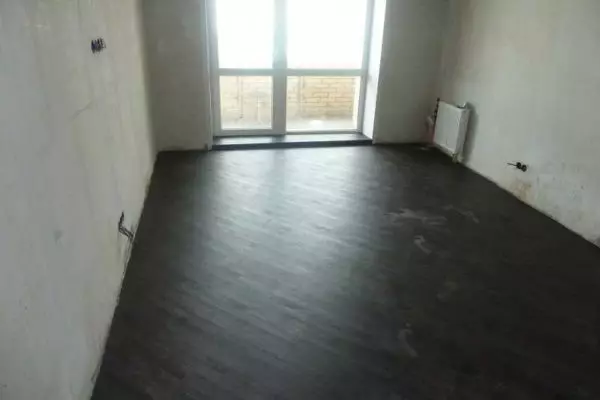
Vinyl floor tile looks presentable
- Nice to walk. Vinyl tile for the floor is non-slip even in wet state. Even in the cold season, it feels like "warm." It was placed in the bath instead of ceramic tiles. The basis was also, but the feelings are much nicer.
- She is "quiet." The PVC tile for the floor without a substrate is laid - right on the base, but it has good sound-insulation properties. She is not ground, in a room with so far coating cozy, and the neighbors do not complain from below.
- When falling acute and heavy items of traces there is no (quartzinyl tile).
In general, almost all unanimously declare that PVC tile for the floor is the best that they have so far. Moreover, "before" were laminate, linoleum, ceramic tile, someone even parquet. The disadvantages were also gathered from reviews. They were not so much:
- The coating is new, so it is incomprehensible how it will behave in the long run. The oldest feedback is 5 years of operation.
- Quartzinyl tiles with a good protective coating costs a lot.
- The coating is still unnatural.
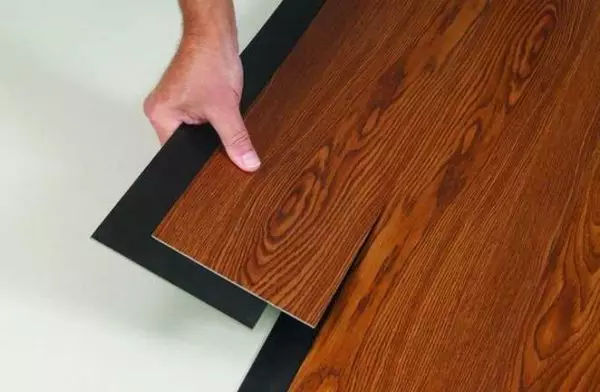
PVC tile for the floor: one of the options with the adhesive lock
As you can see, it is really a good option. Suitable for any premises - technical, residential, with complex operating conditions.
Laying
Actually, laying of vinyl tile is not a very difficult process, but requires accuracy. Special attention is paid to laying the first two rows, which are then based on all the others. There is also a difference in the technique of gluing vinyl tile on glue, laying self-adhesive or with locks. But there are general requirements. Consider all questions more.
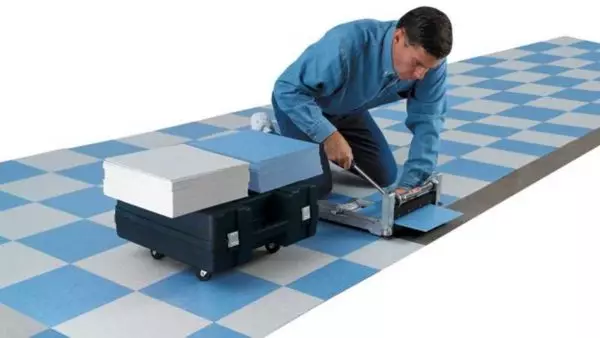
PVC tile for the floor can be square
What tools are needed
It takes a decent set of tools, but they are all inexpensive, many are in the farm. So, you will need:
- Meter steel line. To her, with the back side, glue several pieces of bilateral tape. It is necessary that she "did not go." And so that the tape is not very sticky, suck it with dust, gis, etc.
- Stationery knife with replaceable blade. The knife should be good and comfortable, the holders for blades are better than steel, the blades themselves are durable and sharp.
- If a linoleum floor tile is selected, which is needed to glue, you need a toothed spatula with a fine tooth. The tool for laying ceramic tiles will not fit - "tooth" must be triangular and a few millimeters height. If you do not find this, buy an ordinary, file with the blades to make the necessary feeders - 1-2 mm.
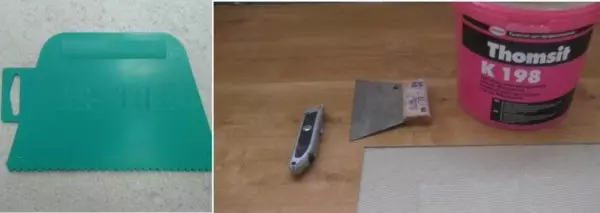
Vinyl panels for gender should be glued to special glue
- Roulette.
- Wide paper tape - 5 cm, several rolls. It is needed if the vinyl tile will be laid on the glue.
- The wipers are a wooden bar, felt, carpet, two-three layers of rigid tissue.
It would be nice to have a construction hairdryer. In complex places - when around the pipes - the tile is more convenient to cut when it is warmed. Then it is not more difficult than cutting household linoleum. And you can warm it only with a construction hairdryer. Heated tile cut, wrap around the pipe, cut off excess.
How to cut PVC tiles
Although the linoleum tile is dense, the straight cuts easily. If you need a cut that will not be shrinking with the edge of the tile, it is easier to work. Cut the blade with an effort on the front side, bend it in the area of the cut, the remaining part is dotted with a knife along the fold line.
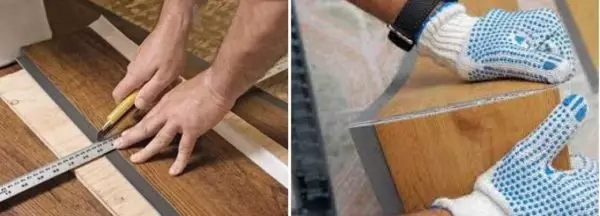
PVC tile cuts for the floor with a conventional knife, then breaks
If the resh should be smooth - for docking with the next tile, it will take a ruler on the scotch - so that it does not move. In this case, it will have to cut through everything from the front side. This is not done at once, but since the ruler will not move, it will be possible to spend the blade two or three times.
Preparation of the foundation
You can put the vinyl tile on the floor alone. It is only important that the base is properly prepared. It should be smooth, clean, dry and hard. PVC tile for the floor can be laid on concrete, a screed of any type, Phaneur, DVP, OBP, GVL and other similar materials.
With concrete floor and tie there is one nuance. The screed from the CPS is obtained too loose and not sufficiently rigid. Under the vinyl tile it is better to align it a self-refined mixture on a plaster basis. It is not difficult and not very expensive, but the result will be excellent.
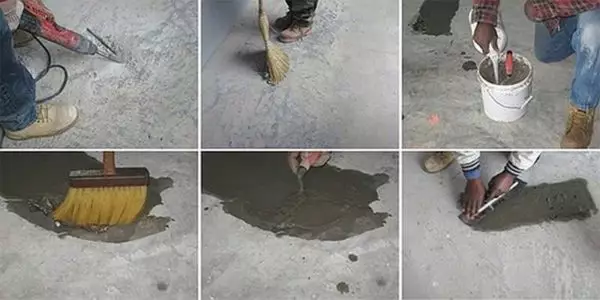
Permissible deviation when laying PVC tiles - 2 mm on a meter
When laying the vinyl tile on the wooden floor, it is equal to plywood 12-15 mm thick. You can use GVL or OSP. All fasteners should be recessed, the holes of the past. Also put the joints between the sheets (do not forget to lay the plates into the dispersion and leave the seams in 2-3 mm - to compensate for thermal expansion). For putting the joints, it is better to use an acrylic putty - it is more elastic and smooth, it is better to have glue tiles. In general, on wooden floors it is not better to put adhesive tile, but floating - with locks of any type (mechanical or adhesive). Less chance of the fact that somewhere the coating will be swelling due to the difference in the magnitude of the thermal expansion.
The last stage of the preparation of the foundation is impregnated with a suitable soil. The base will become even stronger, it will decrease and the absorbent ability will decline, there will be less consumption of glue.
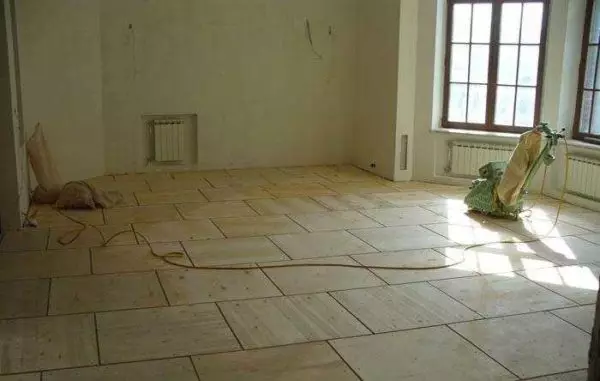
Fiberboard in disintegration
It is still very important that the base was dry. His humidity should not exceed 5%. Measure it with the help of a special device, but there is no place in the household. So you have to do with infrident means. We take a piece of polyethylene without holes and greasy tape. We are tightly glued with a polyethylene scotch to the base (along the edge of several layers) and leave for a day. After a day, we spare and add from the inside. If there is no condensate, everything is fine - the floor is sufficient enough to start laying PVC tiles.
Methods of laying and marking
If the PVC tile laying will be made with their own hands and you are using "skimming", imitating wood, no experience with such material, it is better to start with the simplest scheme - with a displacement. For such a method of laying, it is better if the displacement arbitrary is not visible to the joints. When using this scheme, it is important only that the butchee joints have been separated by at least 15 cm. Such a method of laying is also economical - the sliced piece from the last element in the row can serve as a starting plate in the following (or after one, if the junction turns out to be closer than 15 cm). Other common displacement options are 1/3 and 1/2 of the board length. In this case, the drawing is more regular and joints more stand out.
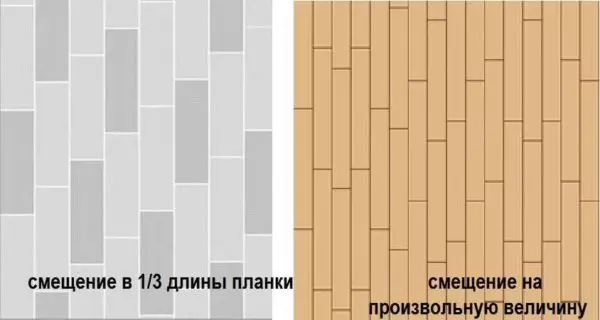
The simplest, but spectacular methods of laying vinyl tiles for the floor
With this method, the layout is usually planks located along the long wall of the room. When using straight PVC tiles, the layout starts from the middle. To determine the location of the starting band find the middle of the room. Then through it, parallel to the walls, conduct a line. Do it with the help of a painting cord or ruler and pencil. This line is guided by laying the first two rows of vinyl tile, combining the edges of the tiles with it. With other methods of layout, everything is more complicated - you will have to calculate, draw, and it is not so easy.
Vinyl tile glue
Glue use special - for gluing PVC coatings. There are compositions of two types: glue and fixation. What glue knows everything, but about fixations in the course, for now, few. This composition is characterized by the fact that does not dry up to a solid state. When it dries out, a sticky substance is left on the surface, similar to the one that is on the scotch. This method is good because the glued coating can be discarded several times. In this, it also looks like a sticky composition of Scotch. PVC tiles on fixation without difficulty, and even through a solid period (several years or dozen years). At the same time, shifted the coating planted for fixation, it will not be possible: lateral displacements are excluded. It is dugs only if they pull over the edge of the tile up.
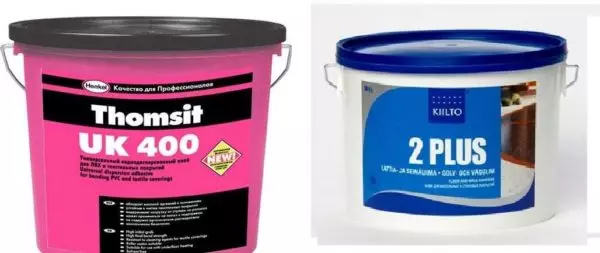
For installation, PVC tiles for the floor uses special glue
No matter what type of adhesive composition you will choose. It is important that he approached for gluing PVC coatings, and was not overdue.
Laying PVC tiles on glue
The glue is applied with a smooth layer on a dry and clean base along the strip-drawn on the floor. The width of the glue band is on the laying of two tiles, if they are long and narrow, length - to the end of the room. Applying glue, it is distributed to a spatula with a fine tooth. There should be no proper or puddle. It is necessary to achieve a uniform distribution. If, according to the instructions for glue, he needs to give a time to dry - wait. If not - you can put right away.
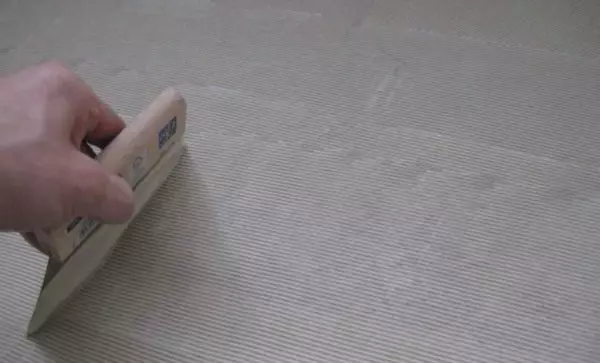
How to apply adhesive for laying PVC germ
The first row laying aligning one edge strictly over the drawn line. When applying glue, try not to lubricate it, otherwise you can go crooked. Put the first tile, changed their hands, kicking out air from under the material. We step on the foot on the stacked tile, put the following, tightly adjusted the joint. It is glitting a piece of painted tape with a length of a latch with a length of about 10 cm. On the laid tile of glue to approximately half, they attract it tightly to the laid and fix the scotch. So the tile does not have a chance to move. Fixing it, stroke, kicking the air. We repeat with the following. When laying a second row, you still fix with the sides using 3 scotch strips.
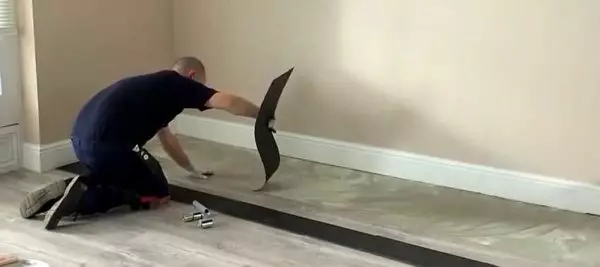
Laying vinyl tile for floor on glue
By setting two rows, we take the clamping bar and we wear a laid coating well. So we drive the air completely. According to the technology, it is necessary to use a clamping roller weighing 50 kg, which rolled fresh coverage. At home, it is not, it has to be replaced. There is another way to gently glue a linoleum tile: after laying it is good to catch it up with a rubber image.
Next, two rows are laid on the other side of the strip. After ordering the laying is no longer so important, but it is very desirable to remove air in one of the ways.
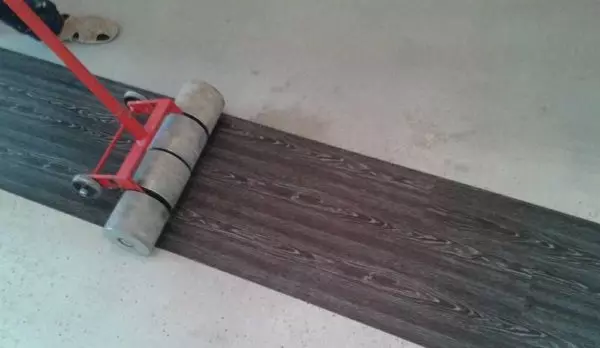
This looks like a rolling roller
Why do you need fixation with scotch, because it rarely use it? In order for the already laid tile not shifted, and this is possible, since the term of complete drying of the glue is 72 hours.
On self-adhesive basis
Self-adhesive PVC tile for the floor is also mounted. The difference is that you do not need to apply glue. Before installing the tile, remove the protective layer, put the tile in place, smooth. The rest of the procedure is the same.
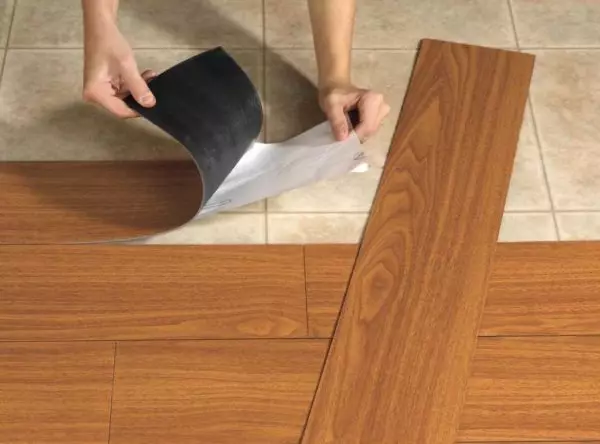
Stack on self-adhesive basis
In this case, the planks can not be recorded by scotch, since the substance on the involving side is sufficiently sticky to keep the coating from the shift immediately after sticking. An important nuance is to press the tiles first to the side surface, holding the bar on the weight. When the edge is docked, gradually lowered the coating, trying to remain as few air as possible.
Laying PVC tiles with lock
The lock on the vinyl tile is mechanical and adhesive. The difference is only in principle of fixation. The remaining rules are the same.
The main difference is the laying of the lock vinyl tile begins on the wall. Planks are located so that the locks "watched" into the room. The first row stacked several millimeters from the wall - to compensate for thermal expansion. This gap can be ensured by setting a piece of material of a suitable thickness or to find thick bars for tiles.
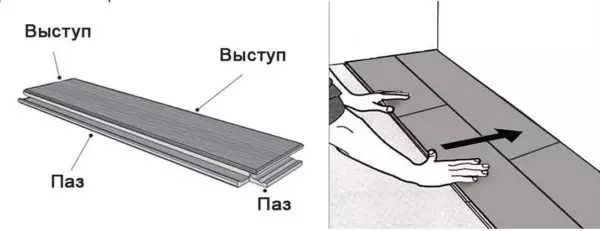
How to lay PVC tiles with mechanical lock
When laying PVC tiles with adhesive lock, you must first shy the end, combining the edges of the ski. Then they connect the lock on the long side and, only after that, the planks are already lowered completely. The edges stroke, checking the density of the entry of the mechanical lock.
The following video shows how the PVC tile on the floor with a mechanical lock is shown. Usually, instructions with pictures are going to the material, but it is also useful too.
The process of laying the vinyl tile with self-adhesive lock is shown in this video. The connection is no less reliable, and the coating assembly is even easier.
Article on the topic: Thank you Mom that you are near the embroidery cross: free country and kids, conventions for a child, needlework
